
In this section you will:
and
Mt. Everest, which straddles the border between China and Nepal, is the tallest mountain in the world. Measuring its height is no easy task and, in fact, the actual measurement has been a source of controversy for hundreds of years. The measurement process involves the use of triangles and a branch of mathematics known as trigonometry. In this section, we will define a new group of functions known as trigonometric functions, and find out how they can be used to measure heights, such as those of the tallest mountains.
[link] shows a right triangle with a vertical side of length
and a horizontal side has length
Notice that the triangle is inscribed in a circle of radius 1. Such a circle, with a center at the origin and a radius of 1, is known as a unit circle.

We can define the trigonometric functions in terms an angle t and the lengths of the sides of the triangle. The adjacent side is the side closest to the angle, x. (Adjacent means “next to.”) The opposite side is the side across from the angle, y. The hypotenuse is the side of the triangle opposite the right angle, 1. These sides are labeled in [link].

Given a right triangle with an acute angle of
the first three trigonometric functions are listed.
A common mnemonic for remembering these relationships is SohCahToa, formed from the first letters of “**S**ine is **o**pposite over **h**ypotenuse, **C**osine is **a**djacent over **h**ypotenuse, **T**angent is **o**pposite over **a**djacent.”
For the triangle shown in [link], we have the following.
Given the side lengths of a right triangle and one of the acute angles, find the sine, cosine, and tangent of that angle.
Given the triangle shown in [link], find the value of
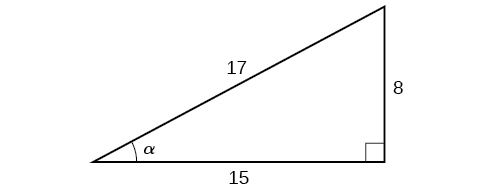
The side adjacent to the angle is 15, and the hypotenuse of the triangle is 17.
Given the triangle shown in [link], find the value of
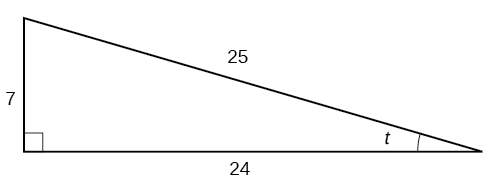
In addition to sine, cosine, and tangent, there are three more functions. These too are defined in terms of the sides of the triangle.
Take another look at these definitions. These functions are the reciprocals of the first three functions.
When working with right triangles, keep in mind that the same rules apply regardless of the orientation of the triangle. In fact, we can evaluate the six trigonometric functions of either of the two acute angles in the triangle in [link]. The side opposite one acute angle is the side adjacent to the other acute angle, and vice versa.
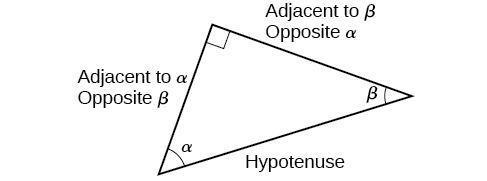
Many problems ask for all six trigonometric functions for a given angle in a triangle. A possible strategy to use is to find the sine, cosine, and tangent of the angles first. Then, find the other trigonometric functions easily using the reciprocals.
Given the side lengths of a right triangle, evaluate the six trigonometric functions of one of the acute angles.
Using the triangle shown in [link], evaluate

Another approach would have been to find sine, cosine, and tangent first. Then find their reciprocals to determine the other functions.
Using the triangle shown in [link],evaluate
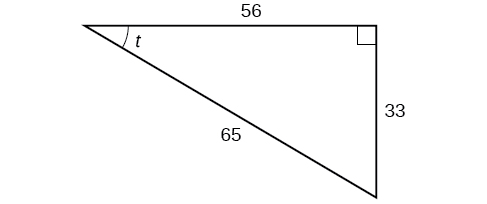
It is helpful to evaluate the trigonometric functions as they relate to the special angles—multiples of
and
Remember, however, that when dealing with right triangles, we are limited to angles between
Suppose we have a
triangle, which can also be described as a
triangle. The sides have lengths in the relation
The sides of a
triangle, which can also be described as a
triangle, have lengths in the relation
These relations are shown in [link].
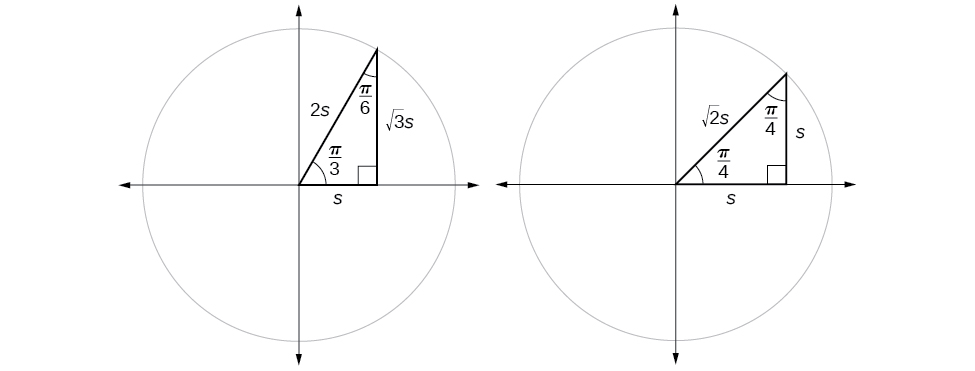
We can then use the ratios of the side lengths to evaluate trigonometric functions of special angles.
Given trigonometric functions of a special angle, evaluate using side lengths.
Find the exact value of the trigonometric functions of
using side lengths.
Find the exact value of the trigonometric functions of
using side lengths.
If we look more closely at the relationship between the sine and cosine of the special angles, we notice a pattern. In a right triangle with angles of
and
we see that the sine of
namely
is also the cosine of
while the sine of
namely
is also the cosine of
See [link].
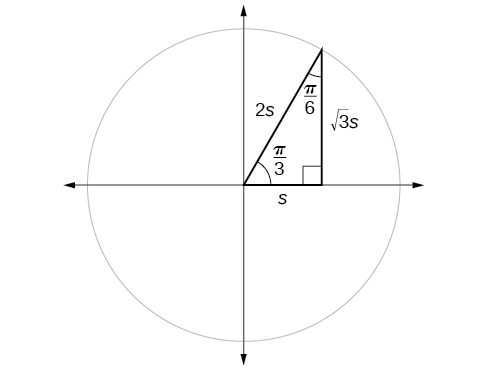
This result should not be surprising because, as we see from [link], the side opposite the angle of
is also the side adjacent to
so
and
are exactly the same ratio of the same two sides,
and
Similarly,
and
are also the same ratio using the same two sides,
and
The interrelationship between the sines and cosines of
and
also holds for the two acute angles in any right triangle, since in every case, the ratio of the same two sides would constitute the sine of one angle and the cosine of the other. Since the three angles of a triangle add to
and the right angle is
the remaining two angles must also add up to
That means that a right triangle can be formed with any two angles that add to
—in other words, any two complementary angles. So we may state a cofunction identity: If any two angles are complementary, the sine of one is the cosine of the other, and vice versa. This identity is illustrated in [link].
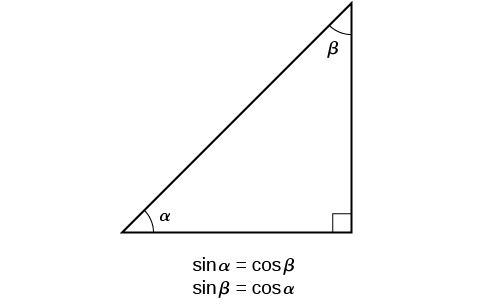
Using this identity, we can state without calculating, for instance, that the sine of
equals the cosine of
and that the sine of
equals the cosine of
We can also state that if, for a given angle
then
as well.
Given the sine and cosine of an angle, find the sine or cosine of its complement.
If
find
According to the cofunction identities for sine and cosine, we have the following.
So
If
find
2
In previous examples, we evaluated the sine and cosine in triangles where we knew all three sides. But the real power of right-triangle trigonometry emerges when we look at triangles in which we know an angle but do not know all the sides.
Given a right triangle, the length of one side, and the measure of one acute angle, find the remaining sides.
Find the unknown sides of the triangle in [link].
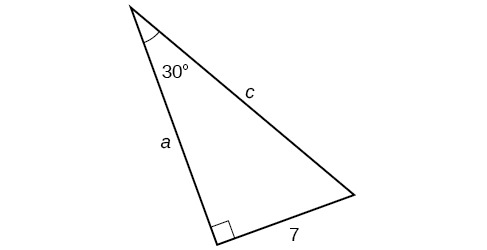
We know the angle and the opposite side, so we can use the tangent to find the adjacent side.
We rearrange to solve for
We can use the sine to find the hypotenuse.
Again, we rearrange to solve for
A right triangle has one angle of
and a hypotenuse of 20. Find the unknown sides and angle of the triangle.
missing angle is
Right-triangle trigonometry has many practical applications. For example, the ability to compute the lengths of sides of a triangle makes it possible to find the height of a tall object without climbing to the top or having to extend a tape measure along its height. We do so by measuring a distance from the base of the object to a point on the ground some distance away, where we can look up to the top of the tall object at an angle. The angle of elevation of an object above an observer relative to the observer is the angle between the horizontal and the line from the object to the observer's eye. The right triangle this position creates has sides that represent the unknown height, the measured distance from the base, and the angled line of sight from the ground to the top of the object. Knowing the measured distance to the base of the object and the angle of the line of sight, we can use trigonometric functions to calculate the unknown height.
Similarly, we can form a triangle from the top of a tall object by looking downward. The angle of depression of an object below an observer relative to the observer is the angle between the horizontal and the line from the object to the observer's eye. See [link].
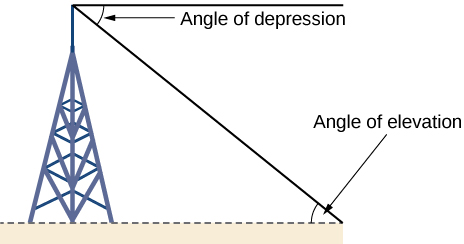
Given a tall object, measure its height indirectly.
To find the height of a tree, a person walks to a point 30 feet from the base of the tree. She measures an angle of
between a line of sight to the top of the tree and the ground, as shown in [link]. Find the height of the tree.
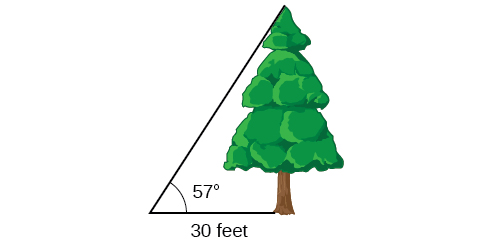
We know that the angle of elevation is
and the adjacent side is 30 ft long. The opposite side is the unknown height.
The trigonometric function relating the side opposite to an angle and the side adjacent to the angle is the tangent. So we will state our information in terms of the tangent of
letting
be the unknown height.
The tree is approximately 46 feet tall.
How long a ladder is needed to reach a windowsill 50 feet above the ground if the ladder rests against the building making an angle of
with the ground? Round to the nearest foot.
About 52 ft
Access these online resources for additional instruction and practice with right triangle trigonometry.
| Trigonometric Functions |
| Reciprocal Trigonometric Functions |
| Cofunction Identities |
For the given right triangle, label the adjacent side, opposite side, and hypotenuse for the indicated angle.


When a right triangle with a hypotenuse of 1 is placed in a circle of radius 1, which sides of the triangle correspond to the x- and y-coordinates?
The tangent of an angle compares which sides of the right triangle?
The tangent of an angle is the ratio of the opposite side to the adjacent side.
What is the relationship between the two acute angles in a right triangle?
Explain the cofunction identity.
For example, the sine of an angle is equal to the cosine of its complement; the cosine of an angle is equal to the sine of its complement.
For the following exercises, use cofunctions of complementary angles.
For the following exercises, find the lengths of the missing sides if side
is opposite angle
side
is opposite angle
and side
is the hypotenuse.
For the following exercises, use [link] to evaluate each trigonometric function of angle
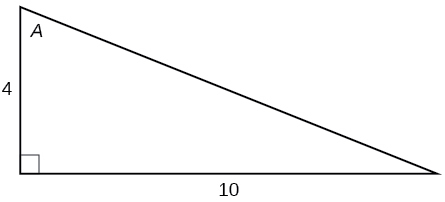
For the following exercises, use [link] to evaluate each trigonometric function of angle

For the following exercises, solve for the unknown sides of the given triangle.
For the following exercises, use a calculator to find the length of each side to four decimal places.
Find

Find
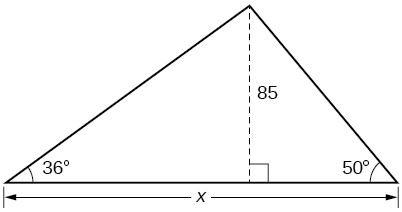
188.3159
Find
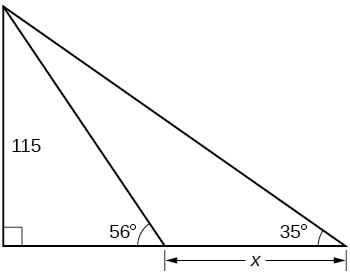
Find
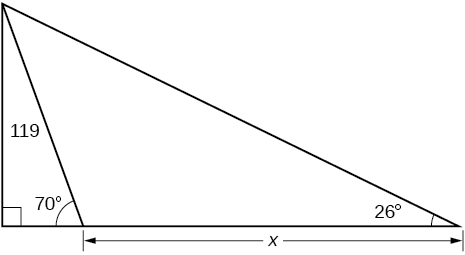
200.6737
A radio tower is located 400 feet from a building. From a window in the building, a person determines that the angle of elevation to the top of the tower is
and that the angle of depression to the bottom of the tower is
How tall is the tower?
A radio tower is located 325 feet from a building. From a window in the building, a person determines that the angle of elevation to the top of the tower is
and that the angle of depression to the bottom of the tower is
How tall is the tower?
498.3471 ft
A 200-foot tall monument is located in the distance. From a window in a building, a person determines that the angle of elevation to the top of the monument is
and that the angle of depression to the bottom of the monument is
How far is the person from the monument?
A 400-foot tall monument is located in the distance. From a window in a building, a person determines that the angle of elevation to the top of the monument is
and that the angle of depression to the bottom of the monument is
How far is the person from the monument?
1060.09 ft
There is an antenna on the top of a building. From a location 300 feet from the base of the building, the angle of elevation to the top of the building is measured to be
From the same location, the angle of elevation to the top of the antenna is measured to be
Find the height of the antenna.
There is lightning rod on the top of a building. From a location 500 feet from the base of the building, the angle of elevation to the top of the building is measured to be
From the same location, the angle of elevation to the top of the lightning rod is measured to be
Find the height of the lightning rod.
27.372 ft
A 33-ft ladder leans against a building so that the angle between the ground and the ladder is
How high does the ladder reach up the side of the building?
A 23-ft ladder leans against a building so that the angle between the ground and the ladder is
How high does the ladder reach up the side of the building?
22.6506 ft
The angle of elevation to the top of a building in New York is found to be 9 degrees from the ground at a distance of 1 mile from the base of the building. Using this information, find the height of the building.
The angle of elevation to the top of a building in Seattle is found to be 2 degrees from the ground at a distance of 2 miles from the base of the building. Using this information, find the height of the building.
368.7633 ft
Assuming that a 370-foot tall giant redwood grows vertically, if I walk a certain distance from the tree and measure the angle of elevation to the top of the tree to be
how far from the base of the tree am I?
and radius 1

You can also download for free at http://cnx.org/contents/13ac107a-f15f-49d2-97e8-60ab2e3b519c@11.1
Attribution: